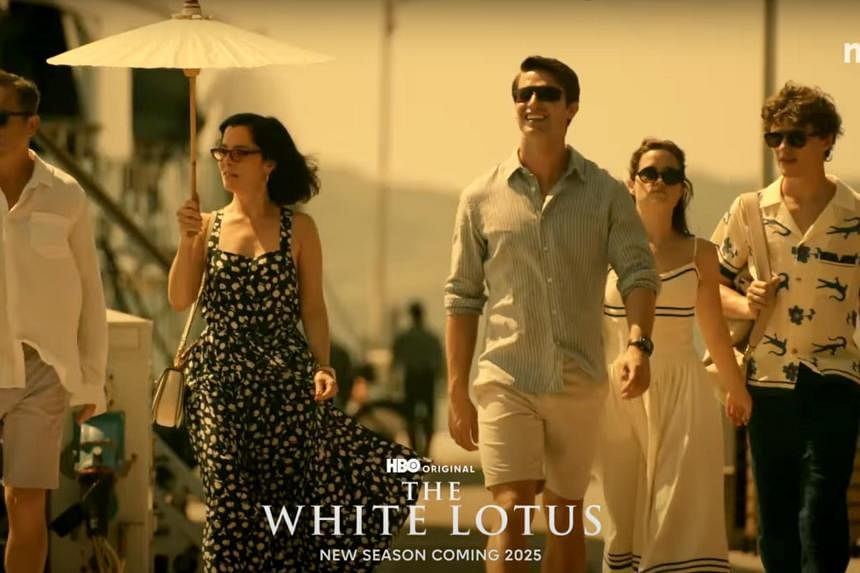SINGAPORE - Asian fans of HBO’s award-winning series The White Lotus (2021 to present) have been looking forward to its upcoming third season, which was filmed in Thailand and features the acting debut of K-pop girl group Blackpink’s Lisa. But the first teaser for the show - set in Bangkok, Phuket and Koh Samui, Thailand’s second-largest island - has sparked online criticism upon its release on Aug 5. Netizens are zeroing in on one aspect: the usage of a noticeable yellow filter.
The six-second clip briefly shows the cast in a resort, walking through Thailand and a shot of a Muay Thai fighter -- along with a voiceover stating, “What happens in Thailand stays in Thailand”. On social media platforms like Reddit, Instagram and X, users - including those from South-east Asia - have voiced their displeasure. “This hideous yellow filter?” wrote one user on X in response to the teaser.

An Instagram user added: “Not the third world country yellow filter.” Users on Thailand’s Reddit forum also mocked it, joking: “They had to film in Mexico to save money.” Another user quipped: “Maybe it’s recorded in Chiang Mai.
” Chiang Mai is a landlocked Thai city known for its heat during the haze season. Some users have taken to posting their own images of Thailand’s natural beauty, showcasing its vivid shades of blue and green to highlight the disparity between the country’s appearance in real life and the show’s version in the teaser. This is not the first time Hollywood has used warm yellow colour grading to depict foreign locales such as India, Mexico and Iran.
Colour grading is a post-production technique used to alter the colour tones of a work. This long-standing trope was evident in crime drama series Breaking Bad (2008 to 2013), where scenes set in Mexico or New Mexico had a yellow and orange tint. The Netflix action film Extraction (2020), set in Bangladesh and starring Chris Hemsworth, faced similar backlash for its heavy use of yellow tones.
Even the first season of The White Lotus depicted Hawaii with a noticeably yellow tint. Ms Abhichana Naiyapatana, a Thai fan of The White Lotus, says she was taken aback by the teaser’s yellow colour grading, which she says is more intense than the colour grading used in the show’s first two seasons. The 26-year-old think tank researcher adds that the yellow-hued teaser came at an unfortunate time when Thai netizens have expressed outrage over similar yellow colour grading in a controversial Apple ad, which was released in July and depicted Apple workers using their products in Thailand.
Apple pulled the ad and issued an apology after criticism from Thai netizens and lawmakers over its use of a sepia tone and misrepresenting the country as underdeveloped. “This depicts narratives about foreigners visiting Thailand, with the yellow tint appearing to symbolise a ‘coloured’ view through which they experience Thailand,” says Ms Naiyapatana, who is based in Bangkok. “I’m actually very curious what their logic is behind this,” adds Thai-American Abby Scripka.
The 27-year-old PhD student notes that Thailand is no stranger to orientalism, being a frequent subject of “positive” stereotypes like being a happy land of endlessly hospitable people. However, in contrast, The White Lotus teaser’s washed-out yellow hues convey the sense of an under-developed and sweltering Third World country, a different form of orientalism that Ms Scripka sees as negative and upsetting. But Dr Adam Knee, dean of Lasalle College of the Arts, cautioned against rushing to judge The White Lotus based on a very brief teaser.
He explains that while yellow or sepia tones are commonly used in desert or Asian settings, it is essential to see the full context before deeming it stereotypical or demeaning. “Certainly there exist shows or films where such tinting is conventionally used to suggest a negative portrayal of a certain setting or country,” says Dr Knee. However, he notes that there is a broad diversity of the use of yellow and sepia hues, which can be an aesthetically driven choice, or be used to convey feelings of cheerfulness or strangeness in different contexts and genres.
The previous two seasons of The White Lotus were set in Maui, Hawaii and Sicily, Italy, and were filmed at Four Seasons resorts in those destinations respectively. Following their premieres in 2021 and 2022, those resorts r eported a surge in bookings. Travel advising platform Virtuoso told The Straits Times in June that it has seen a 39 per cent increase in bookings from clients for the Four Seasons Koh Samui -- one of the third season’s filming locations - where an ocean-view villa can cost about US$1,700 (S$2,300) a night.
The White Lotus 3 is slated to premiere on HBO in 2025..



















